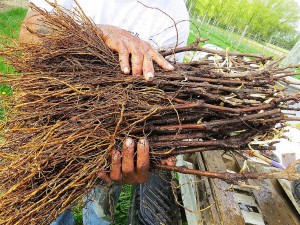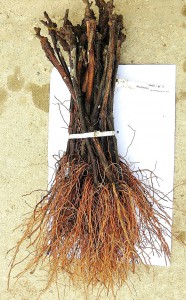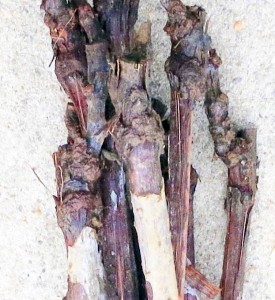Source Planting Materials from Quality Nurseries
The best way to begin ensuring that you have good, healthy and productive grapevines is to source planting material from nurseries that provide clean materials or certified vines. Planting material from nurseries that follow quality assurance protocols reduces the chances of getting diseased or weak planting material.
Certified material means cuttings come from a source block that was properly managed, subjected to regular inspections for insect pests, disease damage, and tested for virus right from propagation through packaging. These nurseries also go through independent third party audits.
Make sure that planting material comes with documents or labels that will help in tracing plants back to the original source. Each bundle of vines should have proper labels describing primary information such as variety, clone, rootstock and some kind of batch number. Make sure your planting material was shipped promptly after packing and came in a temperature-controlled vehicle. Presently there are no certified nurseries in New Jersey; however, there are several certified nurseries available in California and few in Oregon, Washington and New York.
Inspecting Your Wine Grape Planting Material Shipment
Nurseries send planting material on pre-determined dates hence, you should have enough time for a detailed inspection.
Once the shipment arrives,
- Check the labels to make sure you got what you ordered.
- Material (cuttings) originated from other countries should have a quarantine certificate and hard copy documents.
- Make sure that the planting material came in a dormant condition and was still moist and ventilated enough to ensure vines were not soggy or dehydrated during transportation.
- As you open your shipment, vines should look clean, bright and have an earthy aroma. If there are bad odors indicative of rotting vines then identify the batch and avoid planting the entire batch. Use the labels and batch information for requesting compensation or refund.
- Vines should be uniform in size, without scars or damaged buds. Shriveled branches or dried vines are indicators of non-vigorous vines.
- Similarly, roots should be healthy, untwined, downward pointing with fibrous cream-colored branch roots.
- Vines with excessively curvy shoots could be difficult to train on the trellis system and should be sorted out.
- Avoid sourcing planting material from other growers or untested source vineyards. Symptoms of specific diseases may be unseen in sourced vineyards however, your vineyard could provide perfect conditions to spread that disease, especially trunk based diseases such as Phomopsis.

Figure 2. A bundle of grape vines that have broken dormancy and started to grow before arrival at the vineyard. These vines will be weakened and should be rejected.
A Note about Grafted Materials
According to Lucie Morton, a viticulture consultant based in Virginia, destructive testing of a few randomly selected vines from the lot will be very useful to find out the quality of grafts or buddings, for example checking the depth into the pith by disbudding or applying thumb pressure at the graft union.
She also suggests visiting the nursery before you order materials for the first time. Often, to keep up with the high volume orders, nurseries use bench grafting which is more prone to diseases and handling damage than field grafting which is superior.
Remember, that certified material does not guarantee disease-free grapevines after planting; it only ensures that planting material is clean before it goes into the soil. Follow proper cultural practices and spray programs to ensure healthy vine and quality wine grapes.
Resources
Helen Waite, David Gramaje and Lucie Morton 2010. Grapevine Propagation; Principles and Methods for the Production and Handling of High Quality Grapevine Planting Material
Tony Wolf (ed.) 2008. Wine Grape Production Guide for Eastern North America, Plant and Life Science Publishing. NRAES 145
Judit Monis 2013. The Impact of Fungal Trunk Pathogens in Grapevine Nurseries: The International Council for Grapevine Trunk Diseases meets in Valencia, Spain.
Thanks to Rutgers NJAES faculty Gary Pavlis and Dan Ward for their input on this article.



